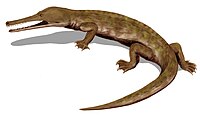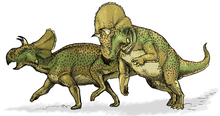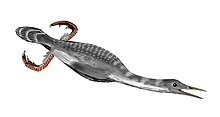
Tyrannosauridae is a family of coelurosaurian theropod dinosaurs that comprises two subfamilies containing up to thirteen genera, including the eponymous Tyrannosaurus. The exact number of genera is controversial, with some experts recognizing as few as three. All of these animals lived near the end of the Cretaceous Period and their fossils have been found only in North America and Asia.
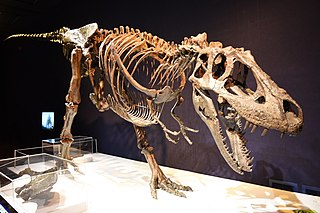
Daspletosaurus is a genus of tyrannosaurid dinosaur that lived in Laramidia between about 78 and 74.4 million years ago, during the Late Cretaceous Period. The genus Daspletosaurus contains three named species. Fossils of the earlier type species, D. torosus, have been found in Alberta, while fossils of a later species, D. horneri, have been found only in Montana. D. wilsoni has been suggested as an intermediate species between D. torosus and D. horneri that evolved through anagenesis, but this theory has been disputed by other researchers.

Gorgosaurus is a genus of tyrannosaurid theropod dinosaur that lived in western North America during the Late Cretaceous Period (Campanian), between about 76.6 and 75.1 million years ago. Fossil remains have been found in the Canadian province of Alberta and the U.S. state of Montana. Paleontologists recognize only the type species, G. libratus, although other species have been erroneously referred to the genus.
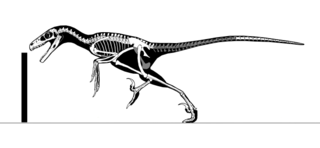
Saurornitholestes is a genus of carnivorous dromaeosaurid theropod dinosaur from the late Cretaceous of Canada (Alberta) and the United States.
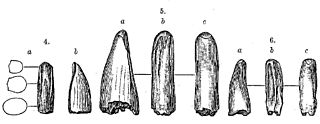
Aublysodon is a genus of carnivorous dinosaurs known only from the Judith River Formation in Montana, which has been dated to the late Campanian age of the late Cretaceous period. The only currently recognized species, Aublysodon mirandus, was named by paleontologist Joseph Leidy in 1868. It is sometimes considered dubious now, because the type specimen consists only of an isolated premaxillary (front) tooth. Although this specimen is now lost, similar teeth have been found in many US states, western Canada, and Asia. These teeth almost certainly belong to juvenile tyrannosaurine tyrannosaurids, but most have not been identified to species level. However, it is likely that the type tooth belongs to one of the species in the genus Daspletosaurus, which was present in contemporary formations, and which matches specific details of the original tooth. The synapomorphies alleged to distinguish the Aublysodontinae, especially lack of serrations on premaxillary teeth could have been caused by tooth wear in life, postmortem abrasion, or digestion. Most other "aublysodontine"-type teeth may be from ontogenetic stages or sexual morphs of other tyrannosaurids.

Montanoceratops is an extinct genus of small ceratopsian dinosaur that lived approximately 70 million years ago during the latter part of the Cretaceous Period in what is now Montana and Alberta. Montanoceratops was a small sized, moderately-built, ground-dwelling, quadrupedal herbivore, that could grow up to an estimated 2.5 m (8.2 ft) in length and 170 kg (370 lb) in body mass.
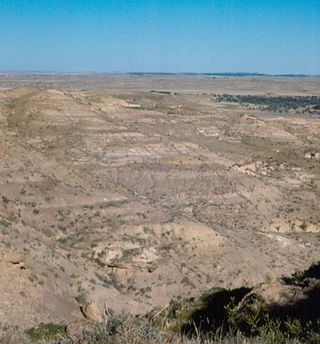
The Lance (Creek) Formation is a division of Late Cretaceous rocks in the western United States. Named after Lance Creek, Wyoming, the microvertebrate fossils and dinosaurs represent important components of the latest Mesozoic vertebrate faunas. The Lance Formation is Late Maastrichtian in age, and shares much fauna with the Hell Creek Formation of Montana and North Dakota, the Frenchman Formation of southwest Saskatchewan, and the lower part of the Scollard Formation of Alberta.
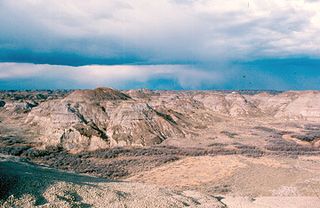
The Dinosaur Park Formation is the uppermost member of the Belly River Group, a major geologic unit in southern Alberta. It was deposited during the Campanian stage of the Late Cretaceous, between about 76.5 and 74.4 million years ago. It was deposited in alluvial and coastal plain environments, and it is bounded by the nonmarine Oldman Formation below it and the marine Bearpaw Formation above it.
The Oldman Formation is a stratigraphic unit of Late Cretaceous age that underlies much of southern Alberta, Canada. It consists primarily of sandstones that were deposited in fluvial channel and floodplain environments. It was named for exposures along the Oldman River between its confluence with the St. Mary River and the city of Lethbridge, and it is known primarily for its dinosaur remains and other fossils.
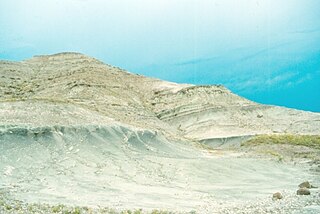
The Two Medicine Formation is a geological formation, or rock body, in northwestern Montana and southern Alberta that was deposited between 83.5 ± 0.7 Ma and 70.6 ± 3.4 Ma, during Campanian time. It crops out to the east of the Rocky Mountain Overthrust Belt, and the western portion of this formation is folded and faulted while the eastern part, which thins out into the Sweetgrass Arch, is mostly undeformed plains. Below the formation are the nearshore deposits of the Virgelle Sandstone, and above it is the marine Bearpaw Shale. Throughout the Campanian, the Two Medicine Formation was deposited between the western shoreline of the Late Cretaceous Interior Seaway and the eastward advancing margin of the Cordilleran Overthrust Belt. The Two Medicine Formation is mostly sandstone, deposited by rivers and deltas.
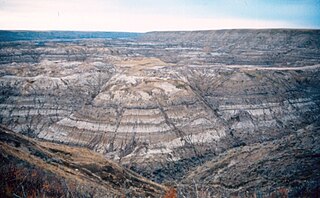
The Horseshoe Canyon Formation is a stratigraphic unit of the Western Canada Sedimentary Basin in southwestern Alberta. It takes its name from Horseshoe Canyon, an area of badlands near Drumheller.

Tyrannosaurinae is one of the two extinct subfamilies of Tyrannosauridae, a family of coelurosaurian theropods that consists of at least three tribes and several genera. All fossils of these genera have been found in the Late Cretaceous deposits of western North America and east Asia. Compared to the related subfamily Albertosaurinae, tyrannosaurines overall are more robust and larger though the alioramins were gracile by comparison. This subfamily also includes the oldest known tyrannosaurid genus Lythronax as well as the youngest and most famous member of the group, Tyrannosaurus rex. There were at least 30 different species of tyrannosaurines.

Albertosaurines, or dinosaurs of the subfamily Albertosaurinae, lived in the Late Cretaceous of United States and Canada. The subfamily was first used by Philip J. Currie, Jørn H. Hurum, and Karol Sabath as a group of tyrannosaurid dinosaurs. It was originally defined as "(Albertosaurus + Gorgosaurus)", including only the two genera. The group is the sister clade to Tyrannosaurinae. In 2007, it was found that the group also contained Maleevosaurus, often synonymized with Tarbosaurus. However, this classification has not been accepted and Maleevosaurus is still considered a juvenile Tarbosaurus or Tyrannosaurus.

The Bearpaw Formation, also called the Bearpaw Shale, is a geologic formation of Late Cretaceous (Campanian) age. It outcrops in the U.S. state of Montana, as well as the Canadian provinces of Alberta and Saskatchewan, and was named for the Bear Paw Mountains in Montana. It includes a wide range of marine fossils, as well as the remains of a few dinosaurs. It is known for its fossil ammonites, some of which are mined in Alberta to produce the organic gemstone ammolite.
The Kaiparowits Formation is a sedimentary rock formation found in the Kaiparowits Plateau in Grand Staircase–Escalante National Monument, in the southern part of Utah in the western United States. It is over 2800 feet thick, and is Campanian in age. This Upper Cretaceous formation was formed from alluvial floodplains of large rivers in coastal southern Laramidia; sandstone beds are the deposit of rivers, and mudstone beds represent floodplain deposits. It is fossiliferous, with most specimens from the lower half of the formation, but exploration is only comparatively recent, with most work being done since 1982. It has been estimated that less than 10% of the Kaiparowits formation has been explored for fossils. Most fieldwork has been conducted by The Natural History Museum of Utah.
The Milk River Formation is a sandstone-dominated stratigraphic unit of the Western Canada Sedimentary Basin in southern Alberta, Canada. It was deposited in near-shore to coastal environments during Late Cretaceous time. Based on uranium-lead dating, palynology and stratigraphic relationships, deposition occurred between ~84.1 and 83.6 Ma.

The Cerro del Pueblo Formation is a geological formation in Coahuila, Mexico whose strata date back to the Late Cretaceous. Dinosaur remains are among the fossils that have been recovered from the formation. The formation is believed to correlate with the Baculites reesidesi and Baculites jenseni ammonite zones, which dates it to 73.63-72.74 Ma.

This timeline of tyrannosaur research is a chronological listing of events in the history of paleontology focused on the tyrannosaurs, a group of predatory theropod dinosaurs that began as small, long-armed bird-like creatures with elaborate cranial ornamentation but achieved apex predator status during the Late Cretaceous as their arms shrank and body size expanded. Although formally trained scientists did not begin to study tyrannosaur fossils until the mid-19th century, these remains may have been discovered by Native Americans and interpreted through a mythological lens. The Montana Crow tradition about thunder birds with two claws on their feet may have been inspired by isolated tyrannosaurid forelimbs found locally. Other legends possibly inspired by tyrannosaur remains include Cheyenne stories about a mythical creature called the Ahke, and Delaware stories about smoking the bones of ancient monsters to have wishes granted.

Thanatotheristes is a genus of tyrannosaurid dinosaur from the Late Cretaceous of Laramidia, approximately 80.1-79.5 Ma. Thanatotheristes contains only one species, T. degrootorum. Fossils of this taxon are found in the Foremost Formation of Alberta, Canada, coexisting with medium-sized ceratopsids like Xenoceratops foremostensis and small pachycephalosaurids like Colepiocephale lambei.

Furcatoceratops is a genus of centrosaurine ceratopsid dinosaur from the Late Cretaceous Judith River Formation of Montana. The type species is Furcatoceratops elucidans.



